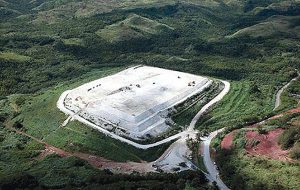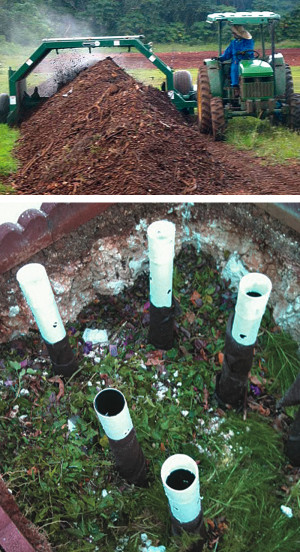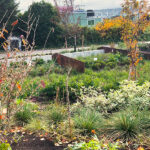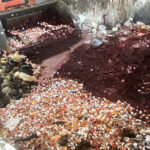With over one million tourists annually and an increase in its military population, the island of Guam is implementing a comprehensive zero waste program.
Marsha W. Johnston
BioCycle February 2014

The Ordot landfill was closed to new dumping in 2011, which elevated the importance of Guam’s Zero Waste Plan.
Guam is one of five unincorporated U.S. territories with an established civilian government, located in the Pacific’s Mariana Islands chain in the Micronesia region. It is 209 square miles in size, with a population of about 160,000. Guam’s primary industry is tourism, hosting over one million visitors annually that flock to its tropical beaches. The island’s second largest source of income is the U.S. military. In terms of solid waste management, the island’s only landfill, Ordot, was targeted for Superfund cleanup in the 1980s, cited for Clean Water Act violations in 2004, put into receivership in 2008 and closed to new dumping in 2011. Recycling has been virtually nonexistent.
Spurred by the situation at Ordot and an impending increase in Guam’s military population, the government of Guam decided to reverse its trajectory. In 2010, it began working to identify new policies, programs and facilities needed to improve its solid waste management. Coinciding with military buildup planning, the government secured funding for a Zero Waste Plan from the U.S. Department of Defense’s Office of Economic Adjustment, which is charged to facilitate the $8.6 billion relocation of 5,000 Marines and 1,300 dependents from Okinawa. Denver-based Matrix Design Group, already a consultant on buildup issues, developed the Zero Waste Plan.
Mark Calvo, director of military buildup for the Governor of Guam, believes the zero waste program would have happened even without the military expansion. “The dynamics of solid waste management changed when the U.S. District Court judge put the Ordot dump in receivership,” he explains. “The Governor asked Matrix, and people in government and solid waste management, what we could do to better position Guam in the long term to reduce landfill waste.”
The receivership order and Clean Water Act violations also resulted in more public environmental awareness about solid waste challenges in Guam, notes Chace Anderson, vice-president of Gershman, Brickner & Bratton, Inc. (GBB), a solid waste consulting firm based in Virginia that was appointed by the District Federal Court to oversee the receivership and address the violations. “Implementation of a receivership to manage the Government of Guam’s broken waste management system certainly has put a focus on trash, recycling, and how best to handle solid waste.” Further, he says, Guam has had two successive governors whose administrations have placed an emphasis on recycling.
Zero Waste Planning
Matrix’s Zero Waste Plan research began at a day-long visioning session in February 2012 with all solid waste stakeholders in Guam, including the Mayors’ Council, legislators, Guam Economic Development Authority, U.S. Department of Defense (DoD), U.S. EPA, Navy, Air Force, University of Guam, Recycling Association of Guam, Guam Contractors Association and the Guam Chamber of Commerce. “Over 90 percent of those invited by the Governor’s Office came,” says Julie Carver, vice president of Matrix.
Last summer, Governor Eddie Calvo accepted Matrix’s two-volume, 614-page, 20-year road map for implementing a Zero Waste Program with 15 different initiatives (summarized in Table 1) divided into the following categories:
• Upstream Source Reduction
• Midstream Reuse
• Downstream Recycling and Organics Diversion
• Global Options (comprising first three categories)
Progress made on the plan to date includes: legislators establishing laws for beverage bottle deposits and food waste recovery; permitting the island’s first commercial composting facility, Ordot Greenwaste Facility, by Guam EPA; and one major island business, Payless Markets, banning plastic bags.
Working with colleagues at the U.S. EPA and Matrix, Guam EPA calculated a baseline for measuring Guam’s recycling rate for the first time in 2011 using data from permitted island recyclers, hard fills (for green waste and different types of construction debris) and Navy and Air Force facilities. Essentially Guam was a blank slate. There was no curbside collection; it had a burning open dump and no recycling measurement. “Guam has accomplished huge milestones in solid waste management,” says Carver. “It has a new landfill, Guam EPA has permitted a commerical composting facility, and DoD is planning to develop a large C&D facility.”
The island had only a recycling pilot of 1,000 households conducted by GBB. In that baseline year, the agencies calculated that the island recycled 17.85 percent of all paper, metals, plastics, batteries, electronics, mulched wood and green waste, or 29,000 tons of material. Construction and demolition debris was not counted, as U.S. EPA does not include C&D debris in its definition of municipal solid waste (MSW).
The next year saw enthusiasm for recycling spread. The Navy further boosted the island’s 2012 recycling rate by 2,000 tons by shifting from using green materials as alternative daily cover at the landfill to using it instead for erosion control. As a result, Guam’s recycling rate for 2012 jumped by 10.28 percent, to 28.13 percent, or 36,834 tons. “We had set a target of a 3 percent increase every year,” explains Guam EPA Administrator Eric Palacios. “The 10 percent really blew us away.” The numbers for 2013 are not yet in, but are expected to be higher still, as curbside recycling was launched island-wide in October, with 15,000 to 19,000 bins distributed to households. By the end of 2014, should be implemented for the vast majority of households.
Moving further toward the zero waste scenario outlined in Matrix’s plan requires more measuring, according to Matrix’s Carver, noting that disposing of C&D and green waste in hard fills is not well documented. “One of our key recommendations was a more intense measurement program,” she says. “We need to accurately size and forecast what’s going to be needed,” adding that low tipping fees and a lack of information about dumping alternatives should be addressed.
To assist in implementation of Guam’s Zero Waste Plan, Calvo drafted the executive order for the Governor to establish a Zero Waste Advisory Group. At the same time, the Guam Legislature, through Sen. Tina Muña-Barnes, committee chair for the environment, has drafted a resolution regarding the Zero Waste Plan. Calvo adds that he anticipates the legislature will enact a plastic bag ban as well.
Moving more aggressively toward zero waste is of critical importance given the cost of disposal on the island. “Capacity is one objective of the Zero Waste Plan, because it costs $10 million to $15 million to open a new landfill cell, and unfortunately for us there have been miscalculations by the receiver,” explains Calvo. “The two cells were supposed to have a 10-year life span at Layon Landfill, but only have a lifespan of four to six years. Those cells cost $38 million.”
Meanwhile, Guam’s Bottle Bill, which was originally passed by the legislature in 2010, was amended recently to clarify issues, such as giving the Guam EPA flexibility to adjust the fee system. The 2010 law states that 5 cents shall be levied on each beverage container being sold on Guam for off-store consumption and be remitted to the government of Guam by deposit beverage distributors. Despite the recent legislative progress, actual implementation is stymied due to the lack of a clearly identified source of funding to manage the program.
The Organics Stream
When it comes to organic waste streams, Guam is taking its first steps. In part because the U.S. District Court Judge did not specify the implementation of any green waste disposal, receiver GBB banned it early on in its management of Ordot, as well as at the new Layon landfill. “We watched the waste coming into [Ordot] and estimated that 30 percent was made up of old corrugated containers, construction and demolition debris and green waste,” notes Anderson of GBB. “After surveying businesses on Guam, we found that there were other disposal outlets for those items. We decided to ban this material in an effort to keep the dump viable while a new sanitary landfill was being built.” The ban, he adds, helped to augment old corrugated container recycling on the island, so GBB chose to continue the ban for the new landfill as well.
Until Guam EPA permitted the Ordot Greenwaste Facility last year, the only active composting facility on the island was at the University of Guam, under the direction of Dr. Mohammad Golabi, associate professor of soil and environmental science (see sidebar). “The soils of Guam are poor in quality in terms of fertility and chemical properties,” Golabi explains. “We want to improve them, so we started using compost made from food and agricultural waste, tree trimmings and grass cuttings. We are studying compost’s agronomic value and environmental impact. So far we have found that when we apply it to agricultural land, we get not only better yield, but environmentally it is very friendly, unlike commercial fertilizer.” He adds that Guam has “a lot” of farmers who want to use compost, especially in northern Guam, which has the island’s only source of groundwater.
Palacios notes that the permitting process for the Ordot Greenwaste Facility generated no opposition, but rather “quite a few” letters of support. He adds that Guam EPA might be considering another composting facility application from a different operator, and believes the composting infrastructure could grow eventually to five facilities. In addition, one of his staff recently achieved certification for composting from the Solid Waste Association of North America, which will be important for allowing the agency to help expand the composting industry.
The U.S. military is said to be planning a green waste and C&D processing facility, but neither the Navy nor the Air Force would provide any details. Palacios says most of the military waste goes into the Layon Landfill, and the rest goes to hard fills. “They crush their glass and keep it on site, and have green waste holding areas, but no permitted composting facility.”
In the meantime, food waste diversion is also progressing. As part of the U.S. EPA’s Food Recovery Challenge, the University of Guam’s Center for Island Sustainability began collecting food waste from the university’s single food service center in January 2013, and giving it to a backyard pig farmer. “Since we started, we have collected almost 4,000 pounds of food waste,” says Elvie Tyler, program coordinator. “The pig farmer is very happy, as it has really helped to support his farm, by saving money on feed.”
Tyler adds that the Center has partnered with the College of Natural and Applied Sciences to expand the project into a pilot with 100 homes that will deliver their food waste to the Center, where it would be cooked, pelletized, and turned into animal feed. The Center also partners with I Recycle, a nonprofit that installs recycling bins in K-12 schools. “I know that there is a heightened need to do food recovery on the island because of our hotels,” says Tyler, adding that most of them have already partnered with pig farmers to provide food waste. “That is why we are promoting awareness, so that maybe a business would see that it could be a good opportunity to do that in food courts.” Meanwhile, Guam Senator Mike Limtiaco is drafting legislation that would identify and divert food waste from the landfill and process it into animal feed.
Markets for compost are still emerging, although Palacios, Calvo and Carver say it has growth potential. “We have a number of hotels and golf courses that invest tens of thousands of dollars in trees and shrubbery to make their facilities stand out,” says Palacios. “I’m sure they would much rather use compost that is healthier for trees and not potentially contaminating our aquifer. We have a huge landscaping market due to tourism, and a high demand for topsoil for replanting.”
Both Palacios and Calvo acknowledge the significant obstacles of receivership, and a lack of funds and manpower to implement the Zero Waste Plan. “We would like [zero waste] to happen sooner, but we are not in full control of our solid waste management,” says Palacios. “Our goal is to have a dedicated staff for the Plan, but like all government entities, we are strapped for cash.” Nevertheless, he adds, the government is intent on succeeding. And concludes Calvo: “We have all lived through the Ordot landfill burning. We have to protect our environment because of our tourism industry. Every year we are getting better.”
Marsha Johnston is a Washington, DC-based freelance writer and communications consultant, specializing in sustainable development and conservation.











